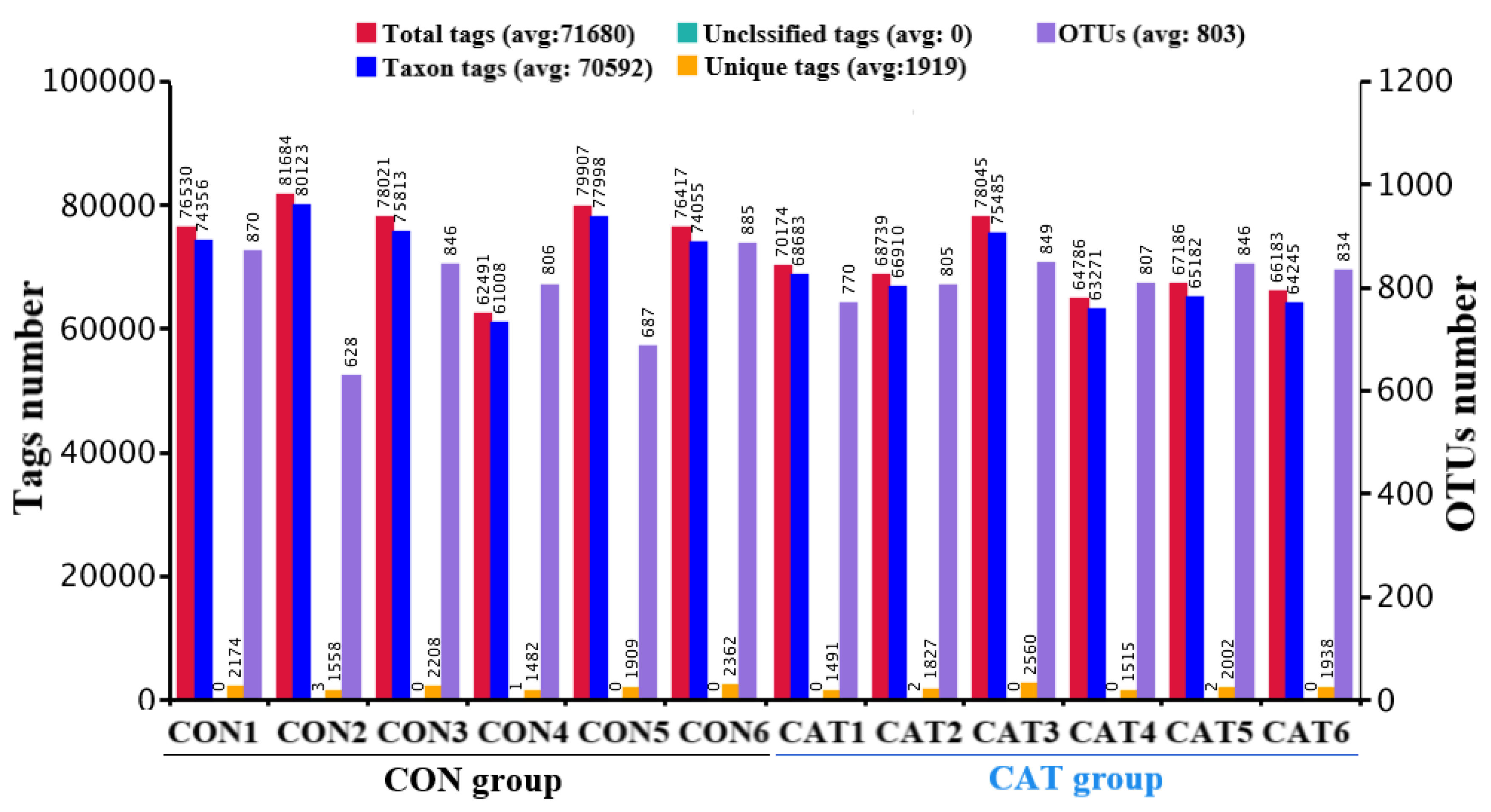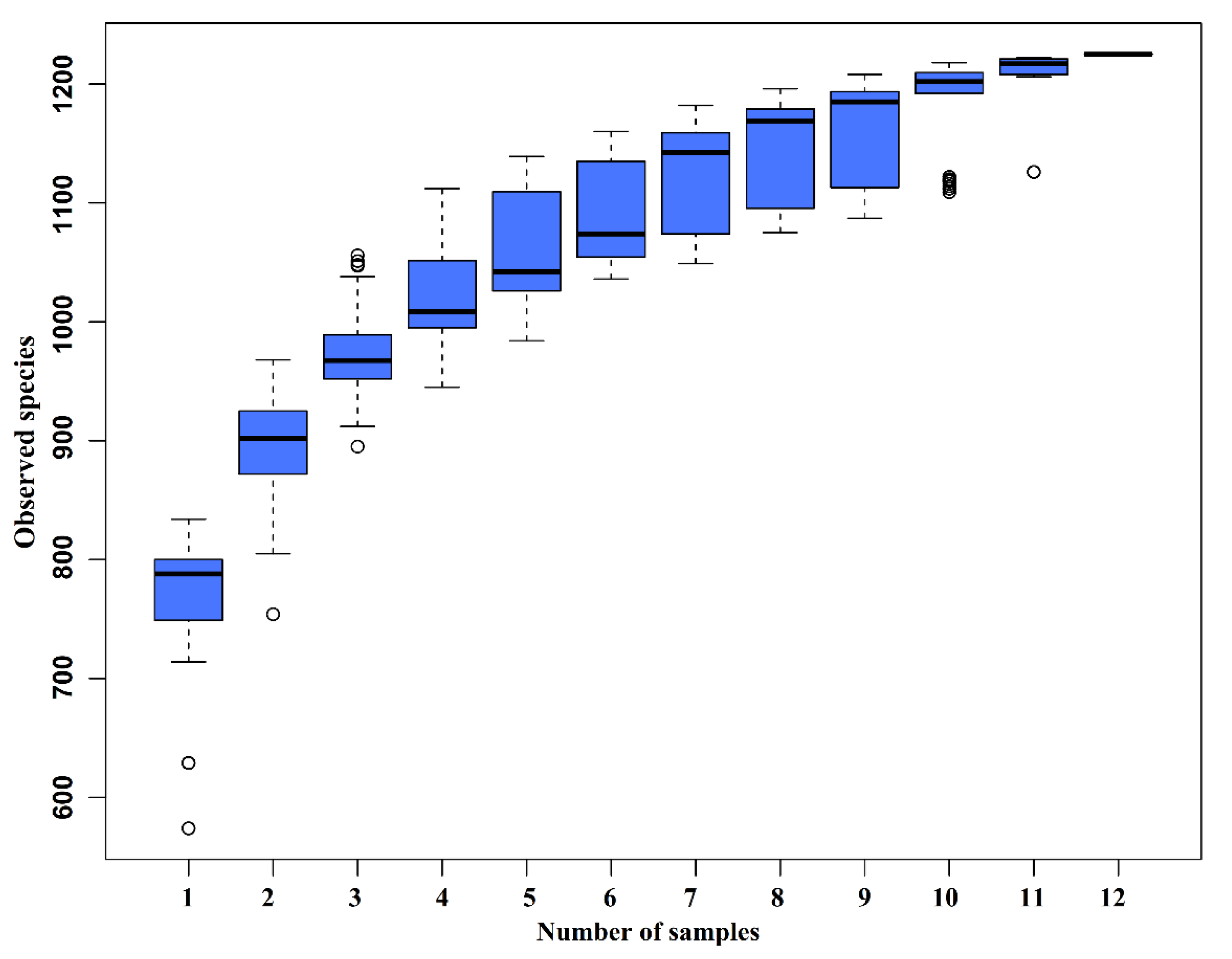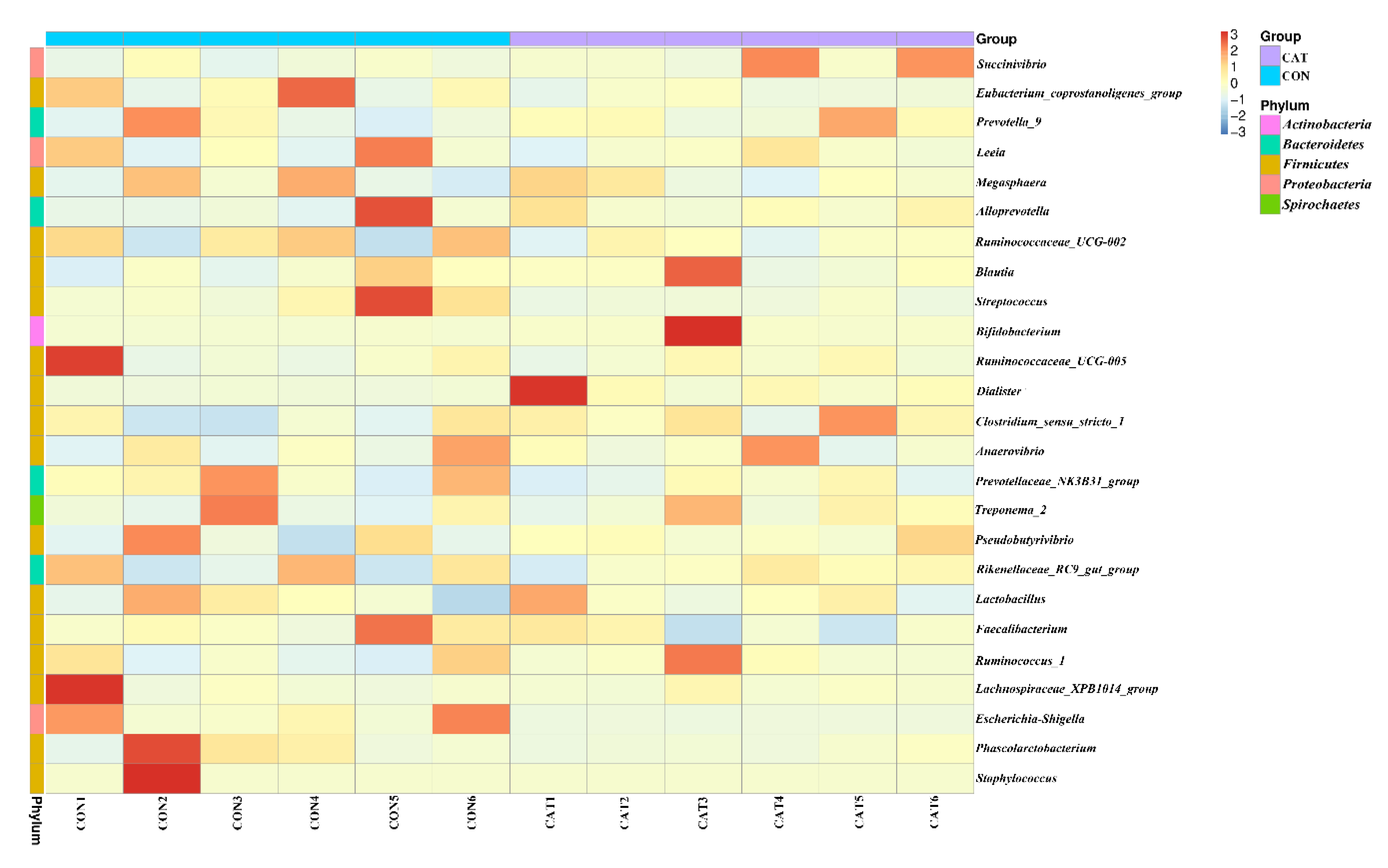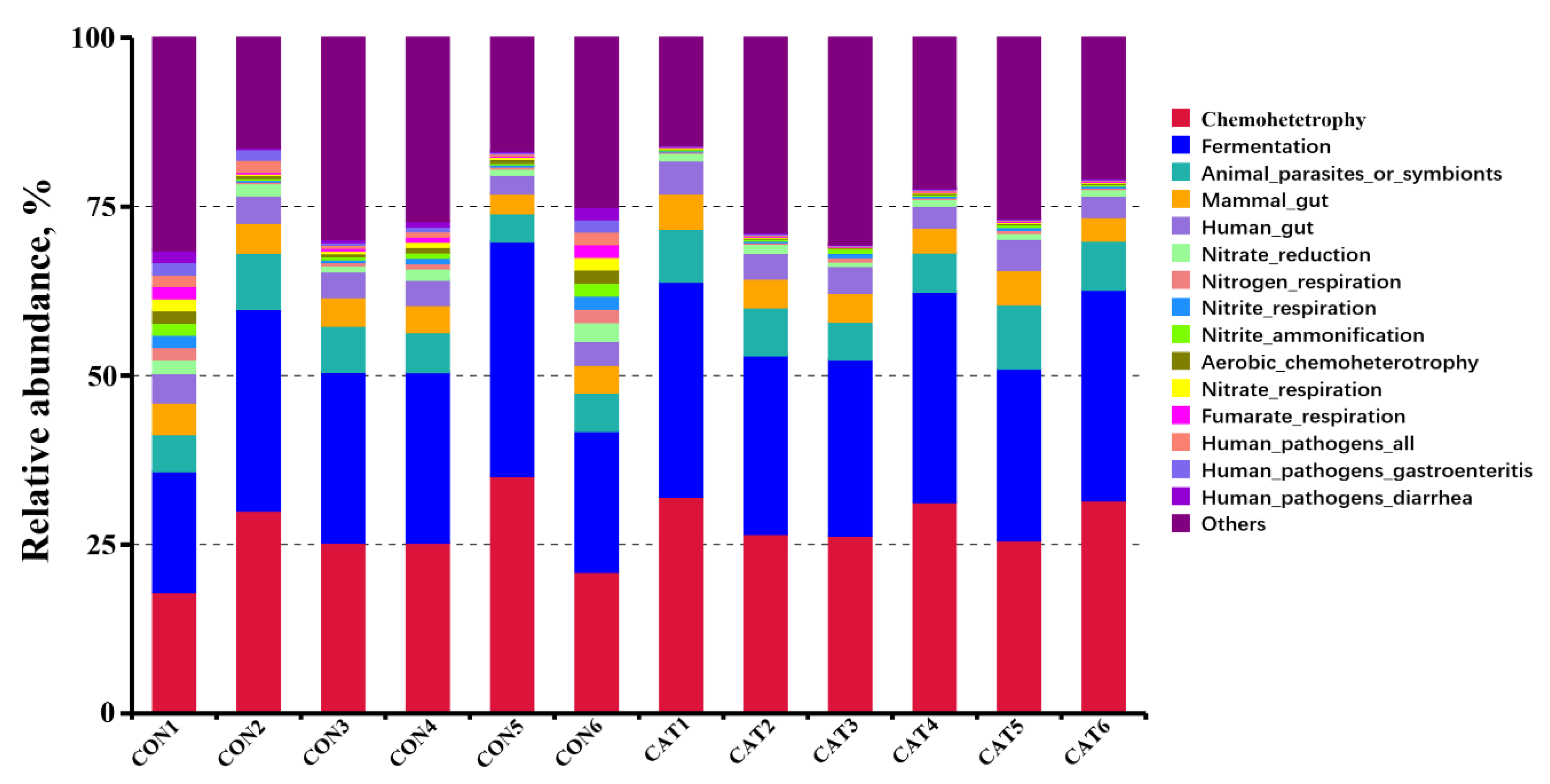1. Introduction
Healthy intestines are not only beneficial to the digestion and absorption of nutrients, but also a crucial safeguard against the invasion of pathogens [
1]. Gut microbiota is a category of microorganisms inhabiting the mammalian gastrointestinal tract, and are involved in maintaining intestinal health in human and monogastric animals, including providing nutrients, optimizing the intestinal immune system, and regulating the growth of the intestinal epithelial mucosa [
2,
3]. Weaning a pig from its sow is one of the most stressful events in a pig’s life [
4]. Weaned piglets suffer from a huge stress response (especially oxidative stress) and changes in gut microbiota because of multiple factors such as environmental factors, weaning, and infection [
5,
6]. A previous study demonstrated that oxidative stress is strongly linked to the alteration of gut microbiota [
7]. Moreover, oxidative stress suppresses intestinal development [
8], weakens intestinal digestion and absorption [
9], and induces mucosa inflammation and cell apoptosis [
10], which can result in growth restriction, disease, and even death in piglets [
11,
12]. Therefore, decreasing postweaning oxidative stress is crucial for weaned piglets.
Hydrogen peroxide (H
2O
2), belonging to reactive oxygen species (ROS), is constantly generated from oxygen in all aerobic metabolism and pathogenic processes [
13]. Excessive H
2O
2 is harmful to almost all cell components, so its rapid and efficient removal is essentially important for aerobically living organisms [
14]. Catalase (CAT), an important antioxidative enzyme in the body, can break H
2O
2 down into O
2 and H
2O and reduce its damage to the body [
15]. In turn, excess ROS also inhibits catalase activity [
16]. Currently, exogenous CAT, which is purified from animal tissues or microorganisms [
17,
18], has been used in pharmaceuticals [
19] and the food industry [
20], as well as by biocatalyst [
21] and other industries [
22]. Wang [
23] suggested that exogenous CAT supplementation in high-fat diets could increase rat antioxidative capacity and improve the intestinal flora structure. Our recent study showed that piglets fed diets supplemented with exogenous CAT had higher gain-to-feed ratios [
24]. However, there was little information available in the scientific literature on the evaluation of the effects of dietary supplementation with exogenous CAT on intestinal development and gut microbial composition of weaned piglets.
In the present study, we investigated the effects of dietary exogenous CAT from microbial culture supplementation on the intestinal development and gut microbiota of weaned piglets, which could be helpful to understanding the microbial mechanisms behind exogenous CAT-modulated intestinal development, and could provide support for the application of CAT purified from microbial fermentation in the feed industry.
4. Discussion
In the current study, dietary CAT supplementation increased the weight of ileums and small intestines, and benefited jejunal villus height and VCR. The weight of intestines has been considered to be an important indicator of intestine development [
26], and it has been thought that higher intestinal weight is related to a thicker intestinal wall and mucus layer [
40,
41]. Intestinal morphology is an important indicator of the health of intestines. The height of the villus determines the ability of the small intestine to absorb nutrients, and the VCR is regarded as a reliable measure to evaluate nutrient absorption capacity of the small intestine [
11]. Decreased villus height and VCR are always accompanied by a decrease in digestibility [
42]. It was illuminated in this study that exogenous CAT might be conducive to digestion and the absorption of nutrients in the small intestine. Consistently, a previous study showed that exogenous supplementation increased feed conversion efficiency [
24]. Further, the maturity and integrity of the intestinal epithelium barrier, which plays a key role in the digestion and absorption of nutrients and provides a physical barrier to protect against infection in the intestinal tract, were evaluated through measuring the concentration of DAO, TGF-α, TFF, and MHC-II in the jejunal mucosa. In the current study, exogenous CAT supplementation increased the concentration of DAO and TGF-α. DAO was found in high concentrations in the small intestine. In the gut, DAO is synthesized by maternal enterocytes and stored in a plasma membrane-associated vesicular structure in the intestinal epithelial cells, and is usually considered to be an indicator by which to evaluate the integrity of the intestinal barrier [
43,
44]. TGF-α, which serves as a polypeptide ligand of the epidermal growth factor or TNF-α receptor, has been reported as being produced by the intestinal epithelial cell and able to maintain the integrity of intestinal epithelial cells [
45]. A previous study showed that increased DAO and TGF-α concentrations were associated with enhanced antioxidative capacity in the jejunal tissue [
11,
28]. The results also suggested a beneficial effect of exogenous CAT on intestinal epithelial barrier functions.
Intestine mucosal damage was usually associated with inflammation [
8]. Previous studies have reported that weaning stress could easily trigger intestinal inflammation in pigs [
46]. Dietary exogenous CAT supplementation decreased the concentration of pro-inflammatory factors (TNF-α and IL-6) and increased the concentration of SIgA. TNF-α is a pleiotropic cytokine produced by activated macrophages, with some metabolic effects on lipid metabolism [
47]. TNF-α signaling can induce activation of the NF-κB signaling pathway, which is considered to be a key inducer of inflammation and programmed cell death [
48]. TNF-α can also activate IL-6 production [
49], which is in accord with the increased IL-6 level in the present study. IL-6, considered to be an inflammatory biomarker, is a multifunctional cytokine that plays a central role in regulating the balance between the IL-17-producing Th17 cells and regulatory T cells [
50]. Activated Th17 cells can produce inflammatory mediators leading to chronic inflammation [
51]. SIgA is secreted by intestinal lamina propria plasmacytes, and serves as the first line of specific defense in the mucosal immune system of the intestine [
52]. The concentration of intestinal SIgA is reduced along with the number of bacteria adhered to the mucosa as it increases [
53].
Early weaned piglets are prone to oxidative stress, which often causes damage to the intestinal mucosa [
8]. A previous study showed that decreasing oxidative stress was a main reason for improving intestinal development in weaned piglets [
28]. In the current study, the redox status in the jejunal mucosa was evaluated through monitoring the oxidative and antioxidative items. We found that dietary exogenous CAT decreased H
2O
2 and MDA concentrations in the jejunal mucosa of piglets. H
2O
2 is one of the major ROSs in the body, and MDA, a secondary product of lipid oxidation, has been widely considered to be an index by which to monitor the degree of lipid peroxidation [
29]. Both H
2O
2 and MDA are closely associated with cell damage. A previous study showed that piglets weaned earlier than normal suckling piglets always had higher H
2O
2 and MDA levels and lower antioxidative enzymes activities in the intestinal tissues [
54]. It has been suggested that piglets fed a diet supplemented with exogenous CAT have lower oxidative stress, which might be related to the increased activities of intestinal CAT and SOD. CAT and SOD are endogenous to important antioxidative enzymes, playing important roles in preventing oxidative damage. SOD can convert ROSs into H
2O
2, then CAT can degrade the H
2O
2 to water and oxygen [
55]. The results in the mice also showed that diets enriched with exogenous CAT could increase intestinal antioxidative enzyme activities such as CAT, SOD, and GSH-Px, while alleviating the intestinal oxidative stress induced by a high-fat diet [
23]. Therefore, exogenous CAT could improve intestinal development by enhancing intestinal antioxidative capacity.
Gut microbiota plays a vital role in host health by providing nutrients, modulating gastrointestinal development, shaping the immune system, and competitively inhibiting pathogens [
56,
57], while the gastrointestinal tract offers a physical environment for microorganisms [
28]. The intestinal mucosa is a particularly dynamic environment where the host constantly interacts with trillions of commensal microorganisms, and periodically interacts with pathogens of diverse natures [
58]. A mature mucosa barrier serves as a primary innate defense against pathogens, and an increased abundance of harmful bacteria will destroy the dynamic environment and result in intestinal barrier dysfunction [
44]. Oxidative stress will modify the intestinal barrier function and finally contribute to the pathogenesis of gut inflammation and microbial flora disorders [
7,
10]. A previous study showed that dietary exogenous CAT supplementation could induce changes in the intestinal microflora of mice [
23]. Similarly, exogenous CAT supplementation significantly changed the structures of gut microbiota in weaned piglets in the current study. Moreover, exogenous CAT increased the relative abundance of
Bifidobacterium and
Dialister, and decreased the relative abundance of
Streptococcus and
Escherichia-Shigella.
Bifidobacterium, considered to be a probiotic bacteria, could decrease inflammation by inhibiting the growth of pathogens via the production of organic acids, and could release soluble factors that suppress the secretion of pro-inflammatory cytokines by immune cells [
59,
60]. A decreased pH value and harmful bacteria (
Streptococcus and
Escherichia-Shigella) were found in the colonic digesta of piglets fed the CAT diet in the present study. Wang et al. [
61] have also reported that supplementation of
Bifidobacteria improves gut barrier function by reducing the damage of the intestinal mucosa. Moreover, the abundance of
Bifidobacterium was positive to antioxidative capacity [
62]. Members of the
Dialister genus are asaccharolytic obligately anaerobic gram-negative coccobacilli, and negatively associated with pro-inflammatory cytokine response [
63,
64].
Streptococcus and
Escherichia-Shigella are both pathogenic bacteria. Higher abundance of
Streptococcus is related to numerous inflammatory response [
65], and
Escherichia-Shigella is prevalent in patients with inflammatory bowel disease [
66]. This indicates that dietary exogenous CAT supplementation increases the abundance of beneficial bacteria and decreases the abundance of harmful bacteria. The results of predicted functions are associated with changes in gut microbiota. The intestinal microflora is dominated by diverse anaerobes, providing both a health benefit to the host and a barrier to infection [
67,
68,
69].
Escherichia-Shigella, a facultative anaerobe, can use nitrate as a terminal electron acceptor for anaerobic respiration [
70], while
Bifidobacterium and
Dialister are anaerobic bacteria. It was reported that the inflammatory host response selectively enhances the growth of commensal
Enterobacteriaceae by generating electron acceptors for anaerobic respiration [
71]. In our study, decreased predicted functions related to aerobic respiration, such as “Aerobic_chemoheterotrophay”, “Nitrate_respiration”, and “Fumarate_respiration”, were observed in the piglets fed the CAT diet. The results suggest that dietary exogenous CAT could promote a proliferation of beneficial bacteria and inhibit the proliferation of harmful bacteria.











